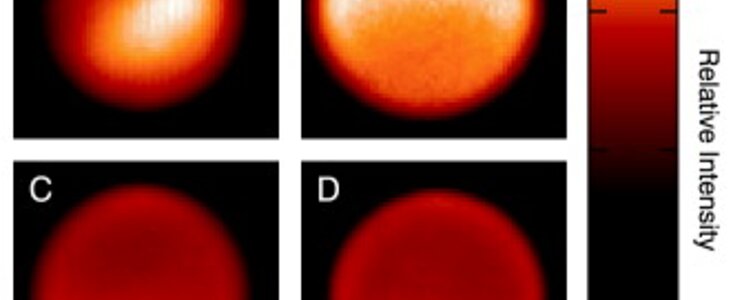Gemini North and Keck Probe Saturn's Moon Titan from Clouds to Icy Highlands
2 Abril 2003
Saturn's moon Titan, the second largest moon in the solar system, is surrounded by a thick atmosphere of molecular nitrogen with a few percentage points of methane. This atmosphere appears to host a variety of meteorological features that show a seasonal cycle.
Titan's apparent angular diameter from Earth (~0.8 arcseconds) can be resolved from the ground only with advanced techniques like adaptive optics. The opacity of Titan's stratospheric haze decreases sharply with wavelengths across the visible into the infrared. There are narrow spectral windows in the near infrared between the methane bands through which astronomers can probe Titan's surface and lower atmosphere.
Henry Roe (University of California, Berkeley) and his collaborators used adaptive optics on the Gemini North and Keck II telescopes to study the tropospheric haze and the discrete clouds of Titan, and to probe its surface (Figure 1). Their observations have revealed that the southern hemisphere shows more cloud activity than the northern hemisphere (Figure 2). Since no tropospheric brightening is seen in the far northern latitudes of Titan, it is suggested that the south polar haze and clouds are of a seasonal origin. During the Titan summer (presently the case in its southern hemisphere), the haze bank is depleted of high concentrations of molecules, such as C2H4, C4N2, CH3CN and C3H8, and cloud activity ceases, especially near Titan's north pole (Figure 2). During Titan's long winter (~8 Earth years), as is currently the case (April 2, 2003) in the northern hemisphere, lack of sunlight drives the chemistry of the lower polar stratosphere towards an extremely different equilibrium relative to the sunlit stratosphere; this increases the concentration of the aforementioned molecules, a process that favors condensation and cloud formation (now seen on the southern hemisphere of Titan).
Meanwhile, the Cassini spacecraft due to arrive at Titan next year will be able to look for these southern polar clouds, and if the mission remains active for more than 4 to 5 years, it will monitor the start of spring cloud activity at Titan's north pole.
This work was published in "Titan's Clouds from Gemini and Keck Adaptive Optics Imaging", The Astrophysical Journal, vol. 581, pp. 1399-1406, 2002 December 20, by H. G. Roe (University of California, Berkeley) , I. De Pater (University of California, Berkeley), B. A. Macintosh (Lawrence Livermore National Laboratory) and C. P. McKay (NASA Ames Research Center).
The Hokupa`a/QUIRC adaptive optics system was developed and operated by the University of Hawai`i Adaptive Optics Group, with support from the National Science Foundation.



